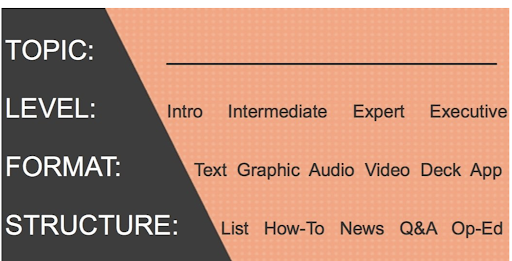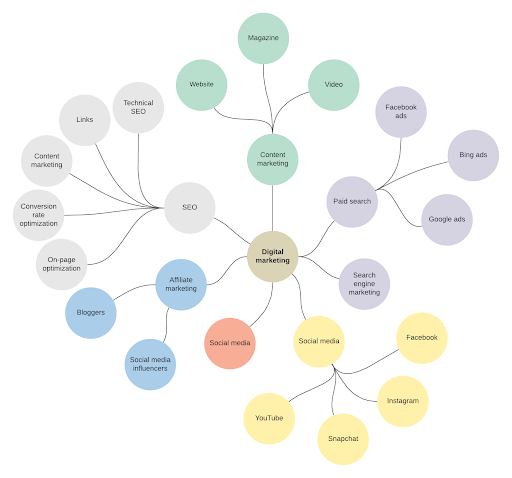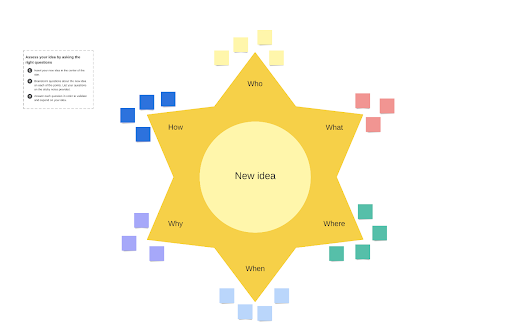For outsiders, creating content for a living may sound like a dream or an easy job. But many marketers understand the struggle of brainstorming content. Whether you’re pitching for a new campaign or trying to fill out the holes in your content calendar, the thought of coming up with brand-new ideas can get overwhelming. To help you, we’ve narrowed down eight effortless ways to brainstorm content ideas.
Why is it important to brainstorm ideas?
As a content marketer, developing effective content strategies is crucial for creating engaging blog posts and captivating your target audience.
Content brainstorming is a fundamental step in content creation, allowing you to generate fresh content ideas and move forward with your marketing initiatives. To brainstorm content ideas, it’s important to consider market trends, collaborative brainwriting, creative thinking, and brand storytelling.
One popular content brainstorming method is collaborative brainwriting, where team members share their ideas on sticky notes or paper. This approach encourages creative thinking and allows for diverse perspectives to be shared.
Another effective brainstorming technique is using a mind map to connect related ideas and stimulate the creative juices flowing visually. Time limits and social media news can also be used as prompts to feel inspired and come up with innovative ideas for your content.
1. Begin with a general theme or topic
Start with a single general theme so everyone entering the brainstorming session is aligned. For example, if you’re creating content for a travel-related brand, your general theme can be “first-time travellers.”
Using the general theme as the starting point lets you focus on specific topics and executions. Marketing expert Jay Acunzo shares a visual that can help guide you during your session:
Defining the “level” of your audience is essential because content created for beginners can look vastly different from content targeted toward experts. While you’re free to use multiple formats (or mediums) and structures, with this method, it’s essential to focus on one at a time.
Once you’ve selected your level, format, and structure, you can list as many ideas as possible. You can repeat the whole process with the same topic but with different answers below. With this structured approach to brainstorming, you can quickly develop highly focused content ideas to fill your content calendar.
2. Contributions from outsiders
The best ideas can come from those outside of the marketing team. While scheduling a face-to-face brainstorming session would be helpful, people who aren’t part of marketing can leave their ideas in a suggestion box or public document.
Including ideas from other team members can provide a different perspective you may have overlooked or missed. Gathering insights from other departments will empower everyone in your company to contribute to decision-making.
Leave a suggestion box on your website and social media pages for valuable insights. You can also use Instagram Story’s sticker tool to ask your followers what they want to see from you. If you’re lucky, you’ll get content ideas ready for execution. Otherwise, collect as much as possible and use them as a starting point.
Take inspiration from Swedish furniture brand IKEA’s Co-Creation landing page, which allows customers to submit product ideas and feedback.
Image Source: IKEA
Creating a separate landing page or platform for feedback and ideas can encourage your customers to regularly contribute their ideas and suggestions.
3. Rapid ideation
Rapid ideation invites participants to think as fast as possible without fear of judgment or questioning. This activity promotes open-mindedness and removes the barrier of overthinking.
Rapid ideation is usually done with Post-It notes or whiteboard markers with a group of five or more. A short time is given (usually a maximum of 10 minutes), during which everyone is encouraged to write down as many ideas as possible without talking to each other.
Image credit: Lucidspark
A strict timeframe gives participants a sense of urgency and encourages them to share ideas they otherwise wouldn’t have thought about in a different setting.
Discussions and questions can only begin when the timer is up. This can help temper dominant personalities and give quiet team members a chance to contribute.
It’s essential to enter a rapid ideation session with a reminder that there are no bad ideas — only creative ones. After the time runs out, participants can vote for the best ideas and start refining them.
The goal of rapid brainstorming sessions is quantity. The more ideas you collect, the more chances of striking gold.
4. Collage of inspiration
Think old-school magazine cut-outs. They’re fun to create and incredibly useful in helping you and your team visualise ideas and inspire creativity. You can find inspiration from websites like Canva that allow you to craft collages from scratch or choose from customisable templates.
Pro-tip: While sticking to digital is more environmentally friendly and efficient, old magazines can help you go back to basics and look to forgotten creative techniques that you can apply to today’s content.
5. Combine ideas
Ask each participant to write down their big ideas on paper. After a set time, instruct everyone to trade papers and build on what their teammates have written down.
Repeat the process until everyone gets back their original sheet. Once the papers have been passed around the entire room, this is the only time that participants can present and discuss what they’ve come up with.
For this brainstorming technique to work, it’s crucial to keep ideas anonymous to avoid bias or shame. This brainstorming method is effective because everyone can work together to improve ideas without fear of judgment or immediate questioning.
This also encourages shy team members to express their ideas and contribute their opinions in a safe space.
6. Revisit old ideas
Always keep a database of past ideas. Just because they were not chosen in the past doesn’t mean they were bad ideas. Using old ideas can help get the ball rolling and spark creativity. Who knows? Something that may have sounded silly in the past can inspire viral content.
You may have had content ideas that seemed impossible in the past due to budget constraints but are now possible today.
Always keep a record of your brainstorming sessions and “wild” ideas. This is your sign to begin if you’ve never recorded rejected ideas from your past brainstorming sessions.
7. Starbursting
The starbursting method can help teams refine ideas and develop concrete ways to actualise them. Once you’ve narrowed down your thoughts, you will have to answer six questions:
- What?
- Who?
- When?
- Why?
- Where?
- How?
The method uses a six-point star, with the centre being your idea and each point representing the different questions.
Image Source: Lucid Spark
Each point of the star should have multiple questions. For example, in “How,” you can ask:
- How can we execute the idea?
- How can I measure the success of the idea?
- How do I want my audience to respond to the idea?
Asking questions instead of immediately seeking solutions can keep your ideas focused and help you evaluate their feasibility. It’s also a great way to vet content proposals and keep everyone on the same page.
8. Go offline
We are constantly glued to our computer screens and mobile phones. While the internet is one of the best sources of inspiration, taking your gadgets during a brainstorming session can lead to more distractions. Participants may be distracted with other work, or notifications may interrupt crucial moments.
Instruct everyone to keep their laptops and phones silent for a productive session. When possible, request a change of scenery. Sometimes a simple trip to the outdoors can spark a creative breakthrough.
How do you brainstorm keywords for SEO?
Keyword research and SEO strategies play a crucial role in content ideation. By understanding search engine algorithms and user behaviour, you can generate ideas based on popular keywords and topics that align with your target audience’s interests. You can use popular SEO tools like Semrush and Ahrefs to find keywords.
Image credit: Semrush’s Keyword Magic Tool
Additionally, staying up-to-date with media news and market trends can provide valuable insights for creating timely and relevant content that resonates with your audience. A successful content marketing strategy involves creating a click-to-tweet or swipe file of creative ideas that can be shared on social media platforms.
Influencer marketing can also amplify your content and increase brand awareness. Successful content stories and customer journey examples can inspire you to develop content that resonates with your target audience and creates a memorable user experience.
Running a brainstorming session
With a proper guide, a brainstorming session can go from productive to a good use of time in minutes. Often, these sessions are dominated by higher-ups or outspoken personalities.
Image credit: YouTube
To prevent this from occurring, here are some helpful tips to spark your creativity and generate engaging content ideas:
Step 1: Have a facilitator
The facilitator will set the session’s tone, keep everyone on the same page, and ensure meeting the goals. Even if all participants are aligned on the agenda of the meeting, without a facilitator, it’s easy to get sidetracked.
Please assign someone with experience handling creative sessions. Your choice of facilitator can positively or negatively affect the outcome. Choose wisely.
Step 2: Enter with a clear agenda
It’s not enough for everyone to enter the meeting knowing they will brainstorm content ideas. You should also define the problem your content is trying to solve. For example, if your goal for the month is to increase sales for a specific product, you must mention that before the session begins. Otherwise, you’ll have too broad ideas and a discussion with no clear outcome.
Step 3: Keep the group intimate
Having too many people in a brainstorming session can mean that not everyone will be heard. Holding a productive conversation with more than ten people is nearly impossible. Keep ten as your maximum, and choose your participants strategically.
For example, in a marketing team, it’s crucial to have a representative of artists, copywriters, social media managers and accounts people. Consider their different personalities and ensure you have a good mix of participants. Of course, choose people who understand the goal of the meeting and have a stake in its outcome.
Step 4: End with action items
A brainstorming session should truly continue once the meeting is over. If you finish the session with great ideas, you must outline what the team should do to accomplish them. Assign point persons, set a timeline for execution, and monitor the progress. If the first session isn’t enough, don’t hesitate to schedule follow-ups.
Wrapping up
Brainstorming is a great way to collect unique ideas from varying perspectives. Plus, it’s an excellent opportunity to build camaraderie between team members and improve your creative problem-solving skills. With these tips, you can host your first session and generate new content ideas in as quick as ten minutes.
Struggling to come up with fresh content ideas for your website or blog? Aperitif Agency can help! Our team of content experts has years of experience in brainstorming and creating engaging content that resonates with your audience.
From blog posts to social media updates, we’ll help you develop a content strategy that drives traffic, engagement, and conversions. Contact Aperitif Agency today and let us help you take your content to the next level.













